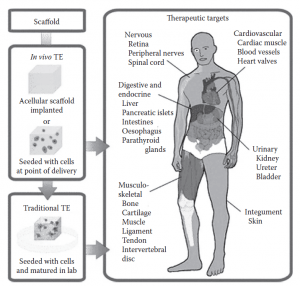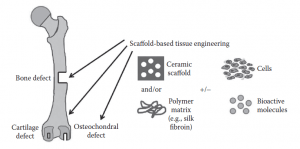Contents:
SCAFFOLD AND SCAFFOLD MATERIAL
Scaffolds are materials designed to induce cell interactions for the formation of functional tissues. They play a pivotal role in the regeneration and repair of tissue. Cells are implanted in a supporting device known as a scaffold that provides support for cells to attach, grow and differentiate. There are four main scaffolding approaches used in tissue engineering:
- Premade porous scaffolds
- Decellularized extracellular matrix (ECM)
- Cells encapsulated in self-assembled hydrogels
- Cell sheets with secreted ECM
In tissue engineering, therefore, cells are implanted into a supporting structural device called a scaffold. This makes it easier for the cells to reshape the scaffold into natural tissue before it is implanted into the body of the patient. However, sometimes the scaffold can be placed directly into the recipient ‘s body, where the host’s own body compartment is used as a bioreactor. Figure 1 shows the different approaches to tissue engineering.

Scaffolds generally meet one or more of the following objectives:
- Allow attachment, migration, proliferation, and differentiation of cells
- Deliver and retain cells and biochemical factors
- Enable adequate nutrient and waste exchange
- Modify the behavior of the cellular phase by exerting certain mechanical and biological influences
Various synthetic and natural polymers can be used as scaffold.
1. Synthetic polymers
a. Polylactic acid (PLA) (C3H4O2)n : Polylactic acid is a biodegradable, thermoplastic polyester with a melting temperature of 173 ° C-178 ° C and a crystallinity of around 37%. It is popular in tissue engineering because of its biocompatibility and dissolvability in the body, where it degrades to form lactic acid, a chemical that is easily removed from the body.
b. Polyglycolic acid (PGA) (C2H2O2)n : is known as a biodegradable, aliphatic polyester since 1954. It exhibits 45 per cent – 55 per cent crystallinity and has a faster rate of degradation compared to PLA.
c. Polycaprolactone (PCL) (C6H10O2)n : known as IUPAC (1,7)-polyoxepan-2-one, PCL is a low melting point biodegradable polyester that is degraded by hydrolysis.
2. Natural polymers
Scaffolds may also be made from natural materials, in particular the different ECM derivatives that have been studied to evaluate their ability to support cell growth. Natural polymers exhibit enhanced performance in biological systems by demonstrating improved cell interactions. Proteinaceous materials, such as fibrin and collagen, and polysaccharide materials, such as glycosaminoglycans (GAGs) and chitosan, have been shown to be beneficial in terms of cell compatibility, excluding minor issues of immunogenicity. Hyaluronic acid alone or in combination with cross-linking agents (e.g. glutaraldehyde and water-soluble carbodiimide) is considered to be the best choice as a scaffolding material. Biomaterial scaffolds have been used to repair and regenerate skeletal tissue through tissue engineering strategies (Figure 2). Another form of scaffolding under investigation is tissue extract from which cells have been removed, and the remaining cellular remnants / extracellular matrices act as scaffolding.

3. Nanomaterials
Nanotechnology has been defined as the understanding and control of matter at dimensions of approximately 1–100 nanometers, where unique phenomena enable novel applications. Nanomedicine is an interdisciplinary field that combines biomaterials with engineering principles for the prevention and treatment of human diseases. Carbon nanotubes ( CNTs), a type of cylindrical nanostructure, have excellent mechanical properties and have been used to improve the mechanical and structural properties of polymer composites. CNTs have been incorporated into polymeric scaffolds due to their biocompatibility, biodegradation resistance and biomolecule functionality. The ECM surrounding cells is characterized by a natural web of nanofibers and is a key factor in modulating a range of biological factors, as well as playing an important role in cell-cell and cell-soluble factor interactions.
Recent advances in nanobiotechnology have made it possible to design and manufacture biomimetic microenvironments that provide an analogue to native ECM as well as Nano scaffolds that exhibit similarities to protein nanofibers in the ECM. Nano fibrosis and nanocomposite scaffolding have been extensively studied in the regeneration of various tissues such as nerve, bone, cardiac / skeletal muscle and blood vessels (Figure 3).

Advantages such as the incorporation of biological factors in Nano fibrous scaffolding by electrospinning or self-assembly techniques can go a long way towards defining the success of nanobiotechnology in tissue engineering. However, the application of nanobiotechnology in tissue engineering is still in its infancy, and a great deal needs to be done in the field of nanotechnology.
REFERENCES :
MORE TOPICS:
